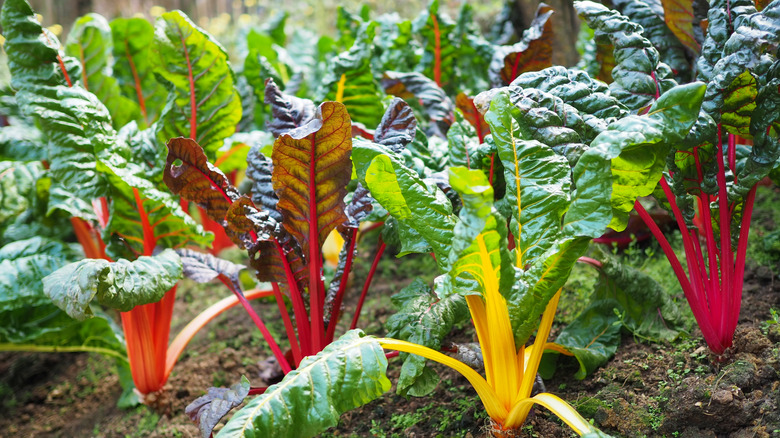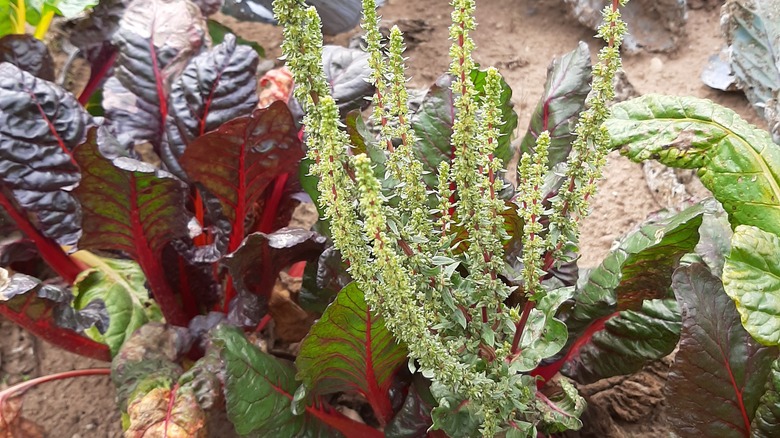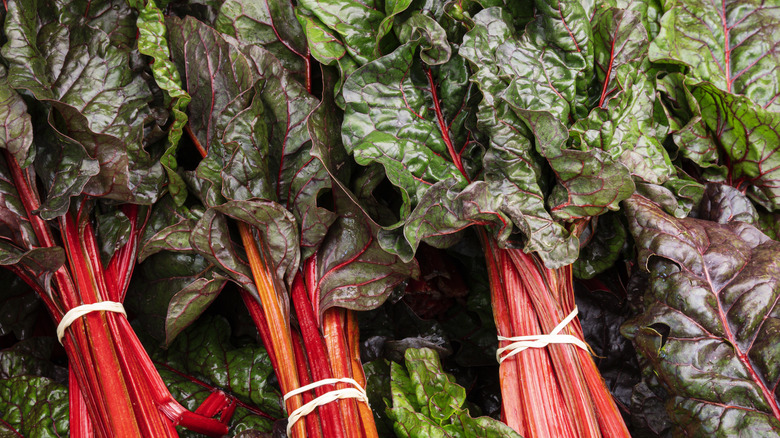The Best Time To Harvest Swiss Chard From Your Garden
If you're confused about the best time to harvest Swiss chard, it could be because the short answer is: Almost all the time. Okay, that's not quite true, but there are some special things about Swiss chard that mean you can be collecting and enjoying this unique veggie almost year round. First, Swiss chard is one of those plants popularly known as "cut-and-come-again," which means you can harvest its leaves and the plant will replace them and carry on growing.
Second, Swiss chard is technically a biennial, which means that in some climates it doesn't bolt until its second (and last) year. When Swiss chard bolts – that is, enters its flower-producing stage – it becomes too bitter to eat. This means that if the plant doesn't bolt, you can essentially harvest it throughout the entire growing season. Third, with a little care you can do a second succession planting of Swiss chard to replace plants that have bolted, and harvest again before the first hard frost. In fact, since Swiss chard can over-winter, in certain hardiness zones you might get a warm spell during which you can even harvest leaves mid-winter. We're going to assume you want to do everything in your power to harvest your Swiss chard as frequently as possible, which means a second planting.
Let's start with the first (spring) planting
More frequent harvests start with earlier planting. For chard, this means starting seeds indoors about 4 weeks before the last frost date in spring, then moving the plants outdoors when you're confident that temperatures won't drop below 28 degrees Fahrenheit at night. Swiss chard is a member of the beet family and prefers cooler temperatures, a fact that will come into play again and again as you're trying to maximize your harvests. It certainly doesn't mind a light frost. So if you start seeds indoors, you can potentially be harvesting in less than two months, when the leaves reach about nine inches tall.
It's important to harvest properly, which determines when (and whether) you can do the next harvest. The key is to remove half (or less) of the leaves, and leave the rest to nourish the plant. As long as you follow this rule, you can harvest the leaves even earlier... there's nothing magical about that nine-inch figure... but it's probably better to delay the first harvest so the plant can establish roots as quickly as possible.
After a few harvests, you get to the tricky part. If your area is hot, this could cause your Swiss chard to bolt and become bitter, which puts an end to your harvesting. As with lettuce, you can delay bolting, to some extent, with row covers or cold frames, but it might be sensible to just re-plant, depending on when the first signs of bolting appear.
Planning successful succession planting
Depending on your USDA hardiness zone, you will likely do your second planting in July or August. Midsummer re-plantings are fine and are, in fact, common. But it's critical that you time everything so that you protect young seedlings from both scorching-hot temperatures and from a hard ground freeze. You can mitigate both using strategies like row covers. But it's less work to manage the timing of your second planting so that the seedlings are less likely to experience unacceptable heat or cold.
Temperature has another effect that you should bear in mind. Mature Swiss chard that experiences some cold nights occasionally is less likely to be bitter than chard that doesn't. This suggests that you will benefit from pushing your second planting date so the first or second harvest is as late in the season as possible. For example, if your first hard freeze is around November 1, you might want to do your second planting as late as early September to get one good harvest, and not much earlier than August 1 for two harvests. (Incidentally, drought has a similar effect on Swiss chard, so keep your crop well-watered.)
And keep an eye on it during the winter. You just might get a warm weather growth spurt, which you can harvest according to the no-more-than-half rule. Swiss chard grown in containers can be easily protected by moving it somewhere warmer, so it will continue growing, if more slowly. This plant seems determined to give as much as possible.


